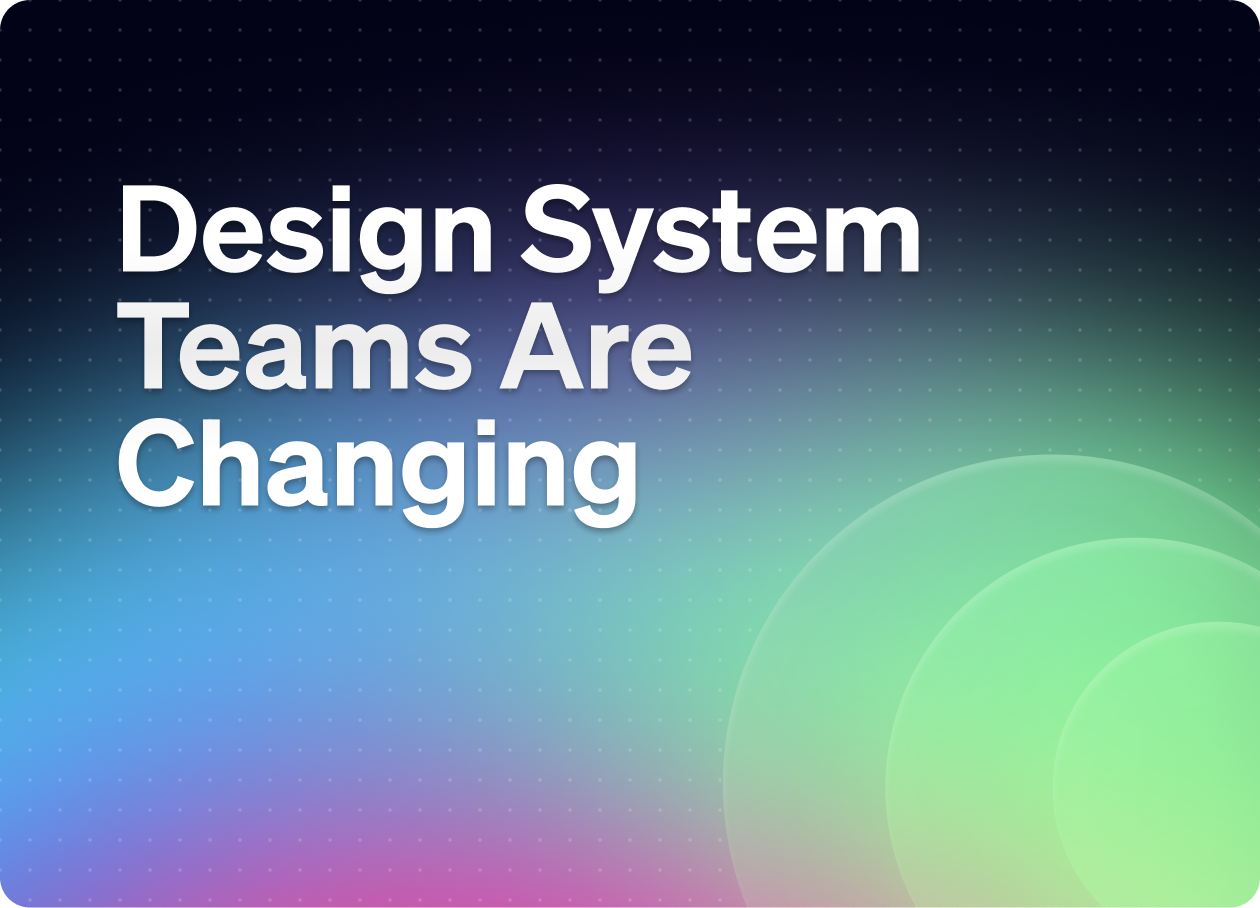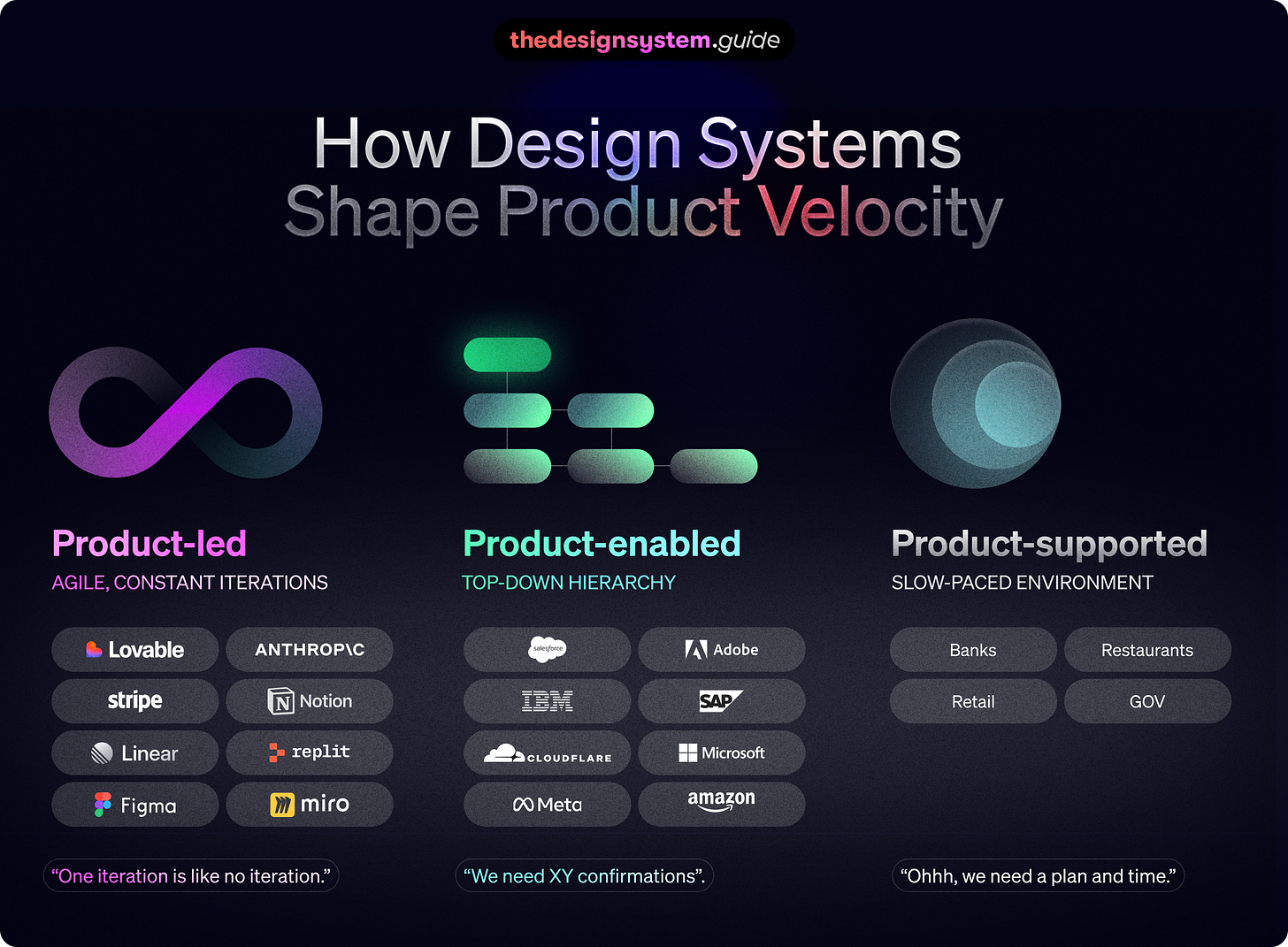Design System Teams Are Dying
How Top Companies Ship Faster
👋 Get weekly insights, tools, and templates to help you build and scale design systems. More: Design Tokens Mastery Course / YouTube / My Linkedin
Over the past few months, I've been asking founders, PMs, and designers a simple question:
"Is your design system serving your product, or is your product serving your design system?"
Most people pause.
The truth is, this single question explains why some companies ship fast and innovate constantly, while others get stuck debating design token names.
In this issue:
The 3 types of design system approaches
Why AI makes this choice even more important
How to shift from “design system-led” to product-led
Which companies are faster?
Many innovative companies have robust design systems. They even have dedicated teams. So what makes them product-led while traditional enterprises remain product-enabled?
It's not about HAVING a design system. It's about who makes the decisions.
When innovative companies need to ship something new, they ask, "What's the best solution for users?" They experiment with new components and patterns, ship them to learn, and then decide whether to incorporate them into the design system.
When slow-moving companies need to ship, they ask, "What can we build with existing components?" Everything must fit the system before it ships.
Same tool, opposite outcomes.
And now AI amplifies this divide. When AI can generate consistent components in seconds and maintain guidelines automatically, the role of design systems fundamentally changes.
The 3 types of companies
🚀 Product-Led (Agile, constant iterations)
Lovable, Anthropic, Stripe, Notion, Linear, Replit, Figma, Miro
"Ship to learn, iterate to win"
Breaking the system for user value is encouraged
⚙️ Product-Enabled (Top-Down Hierarchy)
Salesforce, Adobe, IBM, SAP, Cloudflare, Microsoft, Meta
"Let's check with the design system team."
Breaking the system requires committees
🐌 Product-Supported (Slow-paced environment)
Banks, Government, Traditional Retail
"We need a plan, a roadmap, ..."
Nobody serves anyone
The uncomfortable truth about design systems
That virtuous cycle everyone loves? Scalability → Consistency → Adoption → Cost Savings?
It only works if the cycle serves product velocity. The moment it becomes self-serving (optimizing for system purity over user value) -> you're dead.
When AI can ensure consistency in milliseconds, when components generate on demand, when you can create documentation with prompting, the question isn't whether you need a design system, but who's in charge?
Why AI makes this choice critical
Your competitive advantage isn't the AI model, because everyone will have that. It's your unique data and your flywheel to keep generating it.
In this new reality, agentic AI transforms design systems:
1. From Governance to Intelligence
AI continuously monitors alignment and accessibility
No design police needed; AI maintains guardrails while you create
2. From Documentation to Evolution
AI observes patterns and updates automatically
Systems learn from actual usage, not theoretical perfection
3. From Search to Suggestion
Contextual AI recommends the right path
Guidelines embedded in workflow, not enforced through reviews
Prediction: In 2 years, design system teams as we know them will be gone.
The Old Way: Design System team builds components → Product requests changes/updates → Committee approves
The New Way: Embedded system thinking → AI maintains consistency → Ship faster → System evolves from usage.
The winning teams will merge system expertise directly into product development, creating intelligent systems that maintain what matters (brand, accessibility, quality) while enabling what counts (speed, innovation, differentiation). I already wrote about my view on Experience Systems.
How to move on?
Pick one product team as your pilot
Embed design system expertise directly in that team
Give them permission to break things
Stop tracking component usage → start tracking time to production (time to value)
Celebrate shipped features, not perfect documentation
Use AI to amplify your work
Automate as much as you can
Go from: "Is this in our system?" to: "How fast can we test this with users?"
Reality check
In the AI era, your design system should be invisible infrastructure. The best design system is one your product team doesn't think about. It just works, evolves, and accelerates product goals.
— If you enjoyed this post, please tap the Like button below 💛 Thank you.
💎 Community Gems
Variables Visualizer now comes with the AI Assistant (alpha)
🔗 Link
How to set up and use the Linear MCP server
🔗 Link
Rippling: The leading platform for companies that want to grow faster
🔗 Link
Summer AI inspiration links for designers
🔗 Link





I really love today's newsletter; it provides me with better wording to present my reasons to my team leads next week. Thank you Romina
Interesting perspective!